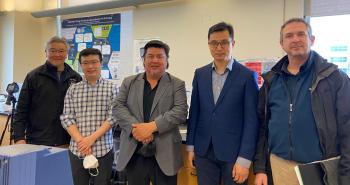Image Caption
Summary
Local Journalism Initiative Reporter
Windspeaker.com
Thanks to conversations sparked from a conference in 2019, officials from Wet’suwet’en First Nation have forged a partnership with University of British Columbia (UBC) reps to develop a possible game-changing product for the world.
A new biodegradable packing foam made from forestry wood waste could potentially help address the global plastic pollution crisis and help keep massive amounts of Styrofoam out of landfills.
Reg Ogen, the president and CEO of Wet’suwet’en First Nation’s Yinka Dene Economic Development Limited Partnership, said his First Nation has been talking about its bioeconomy for at least a half-dozen years now.
Wet’suwet’en reps crossed paths with UBC officials at a Vancouver conference three years ago. Dr. Feng Jiang, an assistant professor in UBC’s faculty of foresty, said only about 50 per cent of harvested trees are utilized in wood industries. The other half is usually left behind in the forest to go to waste.
So, Wet’suwet’en and UBC decided to work together to try to come up with a solution to that waste and add some economic value for the Nation.
“And today we have a product that we believe can change the whole Styrofoam industry,” Ogen said.
Jiang is hoping this new packing foam will be widely utilized in coming years, removing Styrofoam from the environment.
“No one likes Styrofoam, but it is made in packaging because it is lightweight,” Jiang said. “About 30 per cent of landfills in the world now are taken up by Styrofoam. That stays there and will take forever to degrade.”
Ogen is also hoping the newly developed product becomes widely used.
“That’s what everyone is kind of leaning towards," he said. "Let’s get Styrofoam out of our landfills and people’s hands because it’s just too dangerous for our environment, especially as Indigenous groups are looking to have clean drinking water and making sure the salmon highways are cleared and the moose are running and we can continue to collect our medicines and our berries.”
“Everybody is looking for the pot of gold. And we found a nice little nugget in the garbage that they throw away.”
Though they know they have a developed product, there is still much work to do for Wet’suwet’en/UBC partnership.
“At this point we’ve got the product,” Ogen said. “Now we just need to find some more revenue or funds to make a solid plan, whether that be going to a bank or the province or finding a private partner. The doors are open right now.”
Securing a pilot facility where the biodegradable packing foam can be built is a next step.
“We want to start producing this and have this on the market in future years,” Jiang said. “Maybe it can be on the market in a couple of years.”
Originally, discussions centred on trying find a building near Wet’suwet’en, located near Burns Lake in northwestern B.C. But now partnership reps like the possibility of having a location on the Lower Mainland.
“It would be more accessible to investors,” Jiang said.
Ogen said next steps include working on finding potential business partners.
“Things could move fairly quickly,” he said. “It might take a couple of years to put together a site and work with some other Indigenous groups in the province that have a site we could use. There’s still a lot of discussions to happen yet.”
Ogen said now is perhaps not the best time to be thinking about starting up a new business.
“Inflation has been kind of being bothersome to a lot of people in the world these days, because the fuel prices, the grocery prices, everything has gone up, especially for the northern communities," he said. "So it’s not going to be cheap but we’re looking at some investors that would like to work with Indigenous groups.”
Joe Wong, the vice-president of the Yinka Dene Economic Development Limited Partnership, is pleased with the newly-developed packing foam as the First Nation has been on a journey to create a bioeconomy, producing bioproducts, including biochemicals and biomaterials.
“We were able to secure funding from the provincial government. Not very much but enough to get the project going and to get it going for the last two years,” he said.
Local Journalism Initiative Reporters are supported by a financial contribution made by the Government of Canada.

